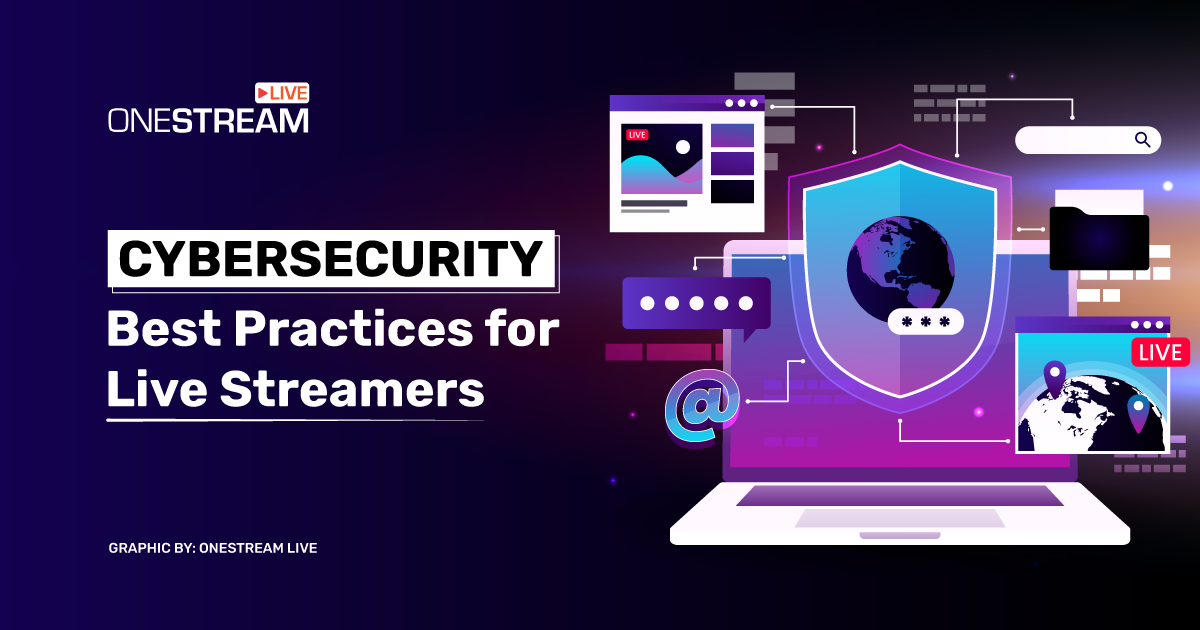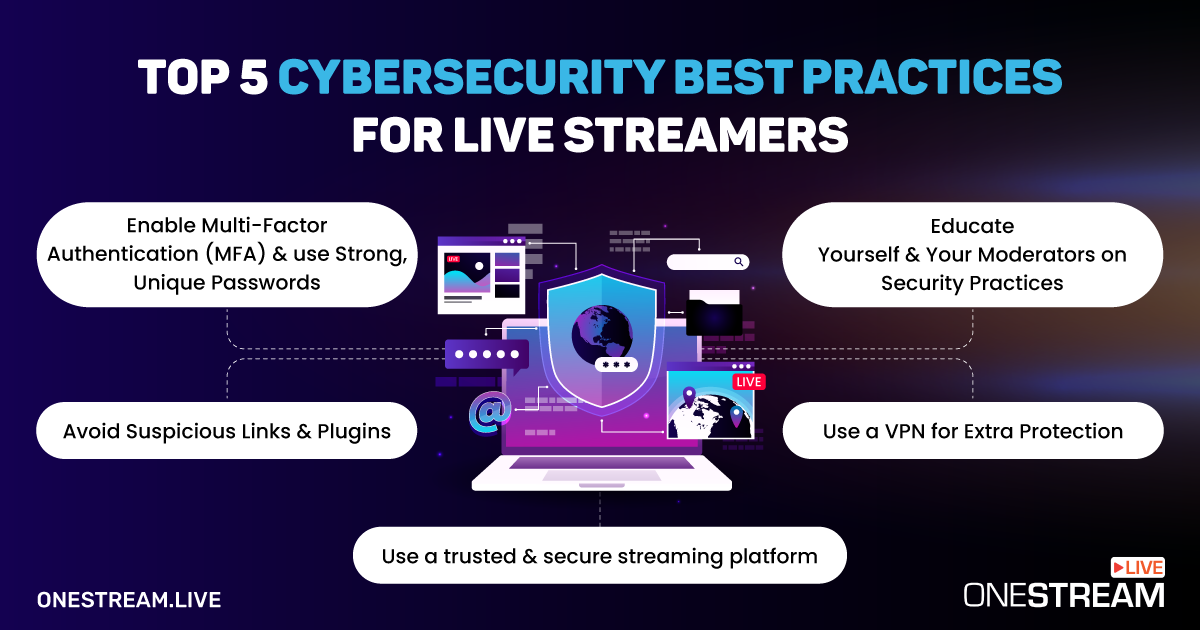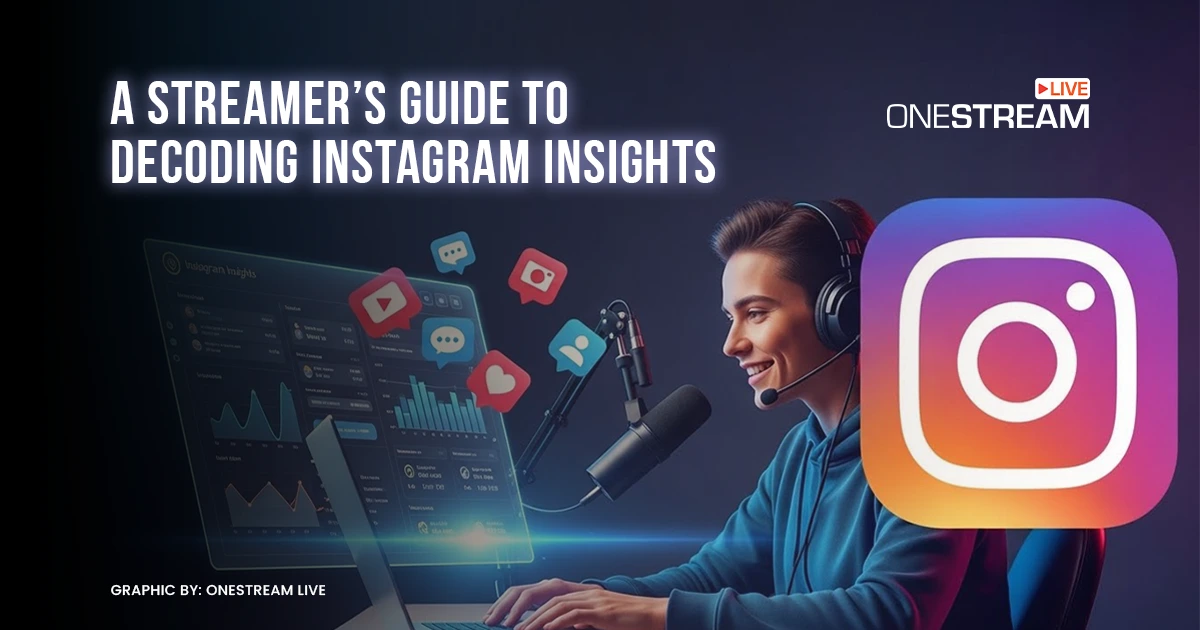As a live streamer, imagine pouring hours, creativity, and energy into building a channel only to see it compromised by a security breach. This means all your hard work, loyal audience, content, and reputation are at risk of being hijacked by cybercriminals. Therefore, understanding and implementing cybersecurity best practices is crucial to protect yourself from such threats.
With live streaming becoming more popular and hackers getting smarter, protecting your content and digital presence is very important for any live streamer who wants to stay safe online. This post will help you understand cybersecurity best practices to safeguard your channel and audience, ensuring your streaming journey remains secure and rewarding.
Importance of Cybersecurity for Live Streamers
Cybercriminals target individuals and businesses across all sectors, and content creators are no exception. Engaging live with an audience opens up vulnerabilities, as hackers can attempt to infiltrate through chat functions, live polls, comment sections, or sometimes even try to manipulate streams or access account settings mid-broadcast.
The global average cost of a data breach in 2024 is $4.88 million, a 10% increase over the previous year. Understanding the importance of cybersecurity can help you as a live streamer proactively protect your channels and also:
- Secure audience trust and privacy: Maintaining the trust of your audience is important. A breach that exposes viewer information or causes interruptions can lead to a loss of trust, which directly affects audience loyalty and engagement. Reliable cybersecurity best practices like using a VPN help ensure that viewer interactions are safe, encouraging audience participation and growth. Protecting viewers’ privacy reassures them that their data won’t be exploited or exposed through the platform.
- Avoid financial losses: For live streamers, streaming is usually a significant source of income, either through ads, sponsorships, donations, or subscriptions. If an account is affected, it can lead to account lockouts or demonetization, which disrupts revenue streams. Protecting accounts with two-factor authentication can prevent unauthorized access, ensuring that revenue remains uninterrupted.
- Safeguard your professional reputation: A data breach or hacked account can significantly harm a streamer’s professional reputation, leading viewers to question the streamer’s credibility and commitment to security. For content creators reliant on consistent engagement, a strong cybersecurity posture reinforces trust and reliability with fans, sponsors, and platforms.
5 Common Security Risks in Live Streaming
Live streaming has transformed digital communication, offering real-time interaction across platforms. However, the increased accessibility and reach of live streaming also bring distinct security risks that content creators, viewers, and platform administrators must address.
Below are 5 major security risks in live streaming:
1. Phishing Attacks
Phishing attacks in live streaming typically target both streamers and viewers. According to CNBC, an average of 30,000 phishing attacks are dispatched daily.
Malicious links are often shared in live chats, enticing viewers to click under the pretense of giveaways or exclusive content. Once clicked, these links may lead to fake login pages or download malware to your device.
2. Stream Hijacking
Stream hijacking occurs when unauthorized users gain control of a live stream through unauthorized access or by manipulating broadcast software. Once hijacked, attackers can broadcast offensive content, interrupt broadcasts, or scam viewers for their selfish gain.
3. Account Hacking
Weak or compromised login credentials can allow cybercriminals to gain unauthorized access to a streamer’s channels, social media profiles, and other online accounts. By accessing a user’s account, hackers can reveal sensitive data, potentially endangering the streamer’s safety and privacy.
4. DDoS Attacks and Swatting
Distributed Denial of Service (DDoS) attacks can disrupt live streaming by flooding the network with traffic, causing lag or downtime. Attackers often target high-profile streams to cause these DDoS disruptions and even make it worse through Swatting.
Swatting is done by tricking emergency services into responding to a fake crisis at a streamer’s location, potentially putting them and their families in danger.
5. Malware and Spyware
Malware and spyware threats often arise when users download unverified streaming software or plugins. This malicious software can monitor users’ browsing history, keystrokes, payment information, or other sensitive data on your device.
These risks can have serious consequences, from financial losses and reputational damage to physical safety concerns and emotional distress. Taking proactive cybersecurity measures to curb these is important for live streamers to mitigate these risks.
Top 5 Cybersecurity Best Practices for Live Streamers
Cybersecurity best practices can make all the difference in keeping live streaming experiences safe and secure. Following these cybersecurity best practices can significantly reduce the likelihood of security breaches and other malicious attacks during your live stream.
1. Enable Multi-Factor Authentication (MFA) and use Strong Passwords
Enabling Multi-Factor Authentication (MFA) and using strong, unique passwords enhances your security by adding another layer of verification (such as an authenticator app or a one-time password sent to a mobile device. This helps prevent unauthorized access even if the password is compromised.
2. Use a Trusted and Secure Streaming Platform
Using a trusted and secure streaming platform is one of the best ways to stay safe during live streaming. Not all platforms are equally secure, and choosing one like Onestream Live, with great multi-factor authentication and security features, can be the first line of defense against common cyber threats.
Using Onestream Live for your streaming activities helps protect your account and personal information, shielding you from phishing, unauthorized access, and even account takeovers. These security measures are essential for protecting your data and viewers from potential attacks.
3. Avoid Suspicious Links and Plugins
During live streams, it’s common for viewers or followers to share links in the chat, but not all links are safe. Attackers may use disguised links to lure you or your viewers to fake sites that steal login information or inject malware into devices. It’s best to be cautious with every link, especially those shared by unknown users, and to remind your audience about the risks as well.
A quick rule of thumb is to never click a link unless you’re certain it’s legitimate, and encourage your viewers to do the same to keep everyone safe. Moreover, reviewing and removing unnecessary or unused plugins can also reduce risks and keep your streaming setup secure.
4. Use a VPN for Extra Protection
A Virtual Private Network (VPN) encrypts your internet connection and conceals your IP address, providing an extra layer of privacy. This is useful when streaming from public or shared networks.
A VPN can protect against DDoS attacks, as it conceals your true IP address, making it harder for attackers to flood your connection.
5. Educate Yourself and Your Moderators on Security Practices
Stay informed about the latest cybersecurity best practices and risks facing live streamers. Educate your audience about online safety and encourage them to report any suspicious activity or harassment they witness during your streams.
Also, familiarize yourself with phishing tactics and ensure you don’t click on suspicious links, especially from unknown sources. If you have moderators, brief them on cybersecurity best practices and encourage them to be vigilant. Many attacks can be mitigated if moderators recognize threats early on.
Wrap Up
Staying vigilant and continuously improving your cybersecurity measures is important to ensuring the long-term success and sustainability of your live streaming career. Take the time to implement these best practices and stay ahead of the curve when it comes to protecting yourself and your viewers from online threats.
OneStream Live is a cloud-based live streaming solution to create, schedule, and multistream professional-looking live streams across 45+ social media platforms and the web simultaneously. For content-related queries and feedback, write to us at [email protected]. You’re also welcome to Write for Us!











